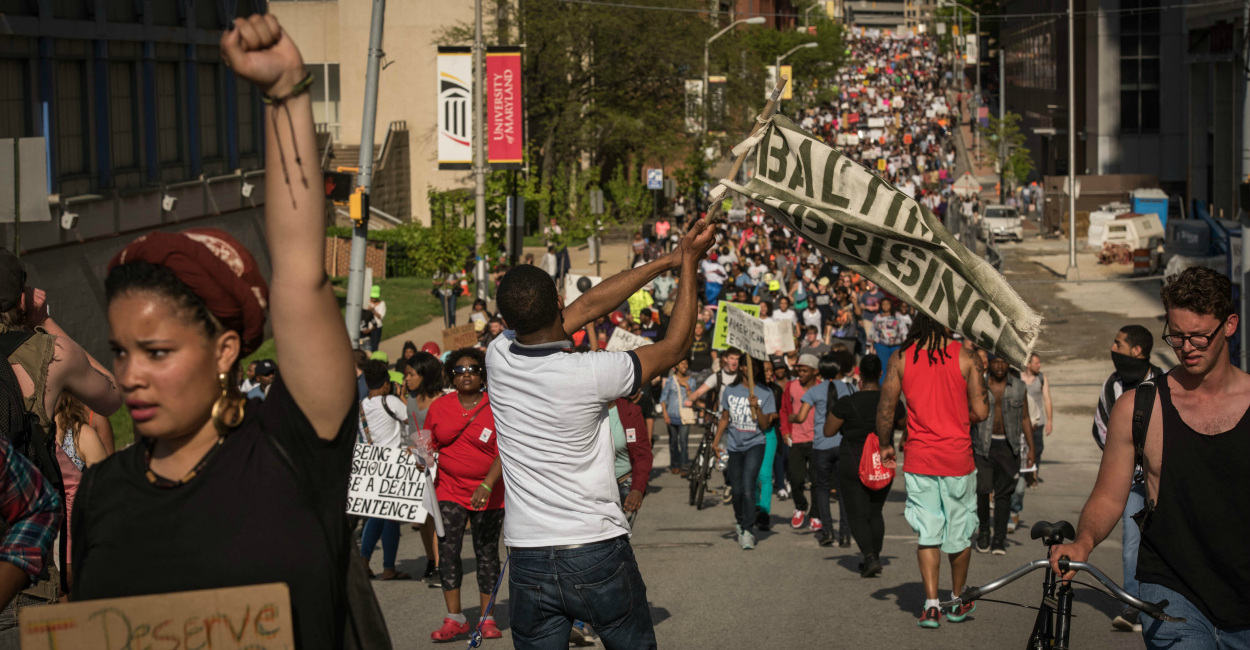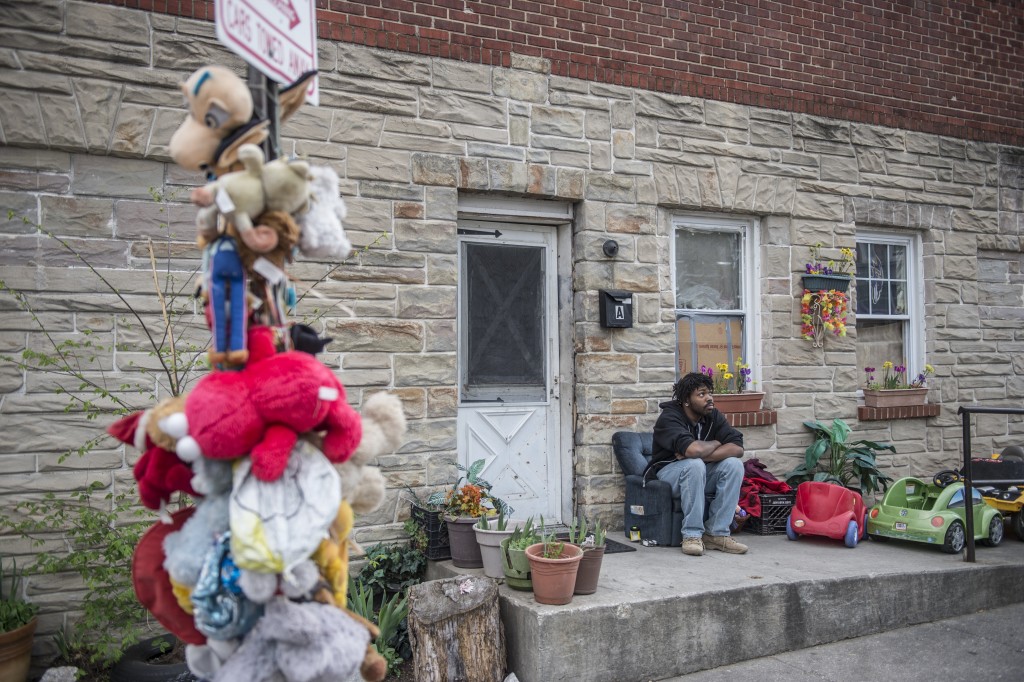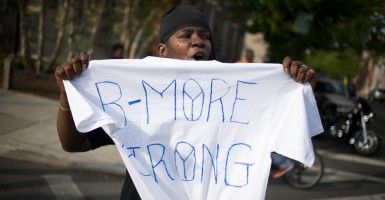The feelings expressed during Baltimore’s recent protests—of being trapped in poverty and circumstance—have roots in a first-of-its-kind policy enacted more than 100 years ago.
In 1910, the Baltimore City Council passed a residential segregation ordinance. It was the first citywide law in the United States that mandated the segregation of each residential block.
“For me as a historian, I think it’s important to go back further than the last 20 years to over 100 years to provide context for what’s happening today in Baltimore,” said Elizabeth Nix, a University of Baltimore historian.
“People were living in certain neighborhoods because that’s where they were allowed to live. If you wanted to move to suburban area, you couldn’t. So the trends have already started. Then, after the courts determine the law to be unconstitutional, some of those suburban areas open up, middle class and professional people move out of city in greater numbers, and you end up with concentrated poverty in areas.”
Before the protests, there was also redlining, a 1930s government program that labeled certain areas as worthy of investment, and others not.
Banks wouldn’t lend to residents in neighborhoods that federally backed officials found to have “undesirable racial concentrations.”
“The inner-city neighborhood with the older housing stock—that mostly white people moved out of—are the ones redlined,” Nix said. “And those areas are left to deteriorate.”
Researchers at Virginia Commonwealth University’s Center on Society and Health have found that Baltimore neighborhoods that were redlined still have lower rates of homeownership and college attainment, higher rates of poverty and segregation, and worse health. The circumstances are hard to move on from.
A study by two Harvard professors shows that among the nation’s 100 largest counties, children face the worst odds of escaping poverty in the city of Baltimore.
“It’s so tragic Baltimore is at the very bottom of that list for possibility of upward mobility,” says Elizabeth Nix.
“It’s so tragic Baltimore is at the very bottom of that list for possibility of upward mobility,” Nix said.
Policy Perspective
Last week, The Daily Signal published a story from the perspective of residents from Baltimore’s black community to understand how a lifetime of experiences boiled over after the death of Freddie Gray in police custody.

Baltimore residents march in a rally May 2 after the death of Freddie Gray in police custody.
(Photo: UPI/Newscom)
Residents spoke of the potential for “new life,” describing how public policy decisions had contributed to the city’s present state, and how they could help bring a better future.
>>> Will Freddie Gray’s Death Inspire ‘New Life’ to Baltimore?
As a follow-up to that story, The Daily Signal asked the same questions of policy experts, to get outside analysis on how Baltimore came to be—the unemployment rate for black men in Baltimore between the ages of 20 to 24 is 37 percent—and how policy can get it out.
Historical View
As a historian, Nix takes the long view.
She connects Baltimore’s erosion to the bit-by-bit demolition of the city’s steelmaking industry. For more than a century, the steel mill at Sparrows Point was a job magnet where thousands of workers fashioned steel for use in cars and appliances. For most of that time, the mill, once the biggest steel producer in the world, was operated by Bethlehem Steel. But it closed in 2012 when then-owner RG Steel went bankrupt.
“Working-class people have found it harder and harder to find jobs that pay a living wage in Baltimore city,” Nix said. “And it’s just not Baltimore. A lot of post industrial cities that used to have good jobs for a large number of people—those jobs have just disappeared.”
As a 20-year Baltimore resident, Nix takes a closer, more intimate view.
Her sons attended Baltimore City Public Schools, a school district that ranked fourth in the country in per-pupil spending in fiscal year 2012, but doesn’t even provide school buses.
“Transportation is a giant issue for students,” Nix said. “If you don’t walk to school, the kids get on public buses. Some kids are on the city bus for an hour-and-a-half before school starts because it takes several transfers to get to their schools.”
The school spending also hasn’t matched performance.
In 2013, 55 percent of Baltimore city’s fourth graders scored “below basic” in reading, with just 14 percent scoring at “proficient” or “advanced” level.
To try and make a difference, and to provide an alternative education source, Nix founded Southwest Baltimore Charter School 10 years ago.
The city of Baltimore has more charter schools than any place in Maryland, but for years funding for such institutions has lagged behind that of traditional public schools despite a state law that requires them to be funded equitably.
Faced with a $108 million shortfall next year, the district school board passed a budget last week that eliminates funding increases for traditional public schools and also gives charter schools less than the $10,000 per pupil they say they need to fund operations.
“Our per-pupil funding has gone down and costs have gone up, so we don’t know how that’s going to work,” Nix said of Southwest Baltimore Charter School, which has 420 students.
Nix says the lack of spending on charter schools undermines the idea that innovative approaches offered by charters fill a unique need in a district that needs any help it can get.
“Schools are really a problem we haven’t been able to solve,” Nix said.
Community Investments
There is little doubt that Sandtown-Winchester, the neighborhood where Freddie Gray lived, is among the hardest hit in Baltimore. But it’s not for a lack of trying to make it better.
In the early 1990s, former Baltimore Mayor Kurt L. Schmoke, a Democrat who was the city’s first elected black mayor, launched an effort to invigorate Sandtown.
In a public-private partnership, developer James Rouse, who developed Inner Harbor, and city officials spent more than $130 million on the community, focusing the core of their efforts on affordable housing, but also prioritizing schools, crime, the economy and health services.
Today, there are more people from Sandtown held in state prisons than there are from any other census tract in the state. According to The Baltimore Sun, it costs the state $17 million a year to care for those inmates.
A 2011 report on Sandtown and an adjacent area, Harlem Park, showed those two neighborhoods had roughly double the city’s rates of unemployment, poverty, homicides and shootings.
In an interview, Diane Bell McKoy, president and chief executive of Associated Black Charities and a former top aide to Schmoke, prefers to talk more broadly about policy’s potential—or sometimes, failure—to transform.
“It’s a hard conversation to have because no one looks at the intersection of local, state and federal policy and its impact on communities,” McKoy says in response to a question on the Sandtown effort. “People don’t understand that policy is not universal. Policy plays out differently in people’s lives.”
In her role with Associated Black Charities, McKoy is an advocate for public policy impacting the black community. She says the biggest problem holding back the black community is a cycle of incarceration that makes people feel “devalued” and “disrespected.”
“If you use policy to devalue people’s lives you will get angry people,” says @BlkPhilanthropy.
Last week, the U.S. Justice Department announced it will investigate whether the Baltimore Police Department has engaged in a pattern of unconstitutional policing.
“If you use policy to devalue people’s lives you will get angry people,” McKoy said. “There was a time in this country you could serve your time and reintegrate into this country. Today, having that on their record means they almost can’t get a job. So you serve your time. It’s not a murder. But you’ve still been relegated. You did it, you are a bad person, and we are never going to give you an opportunity: devalue, devalue, devalue.”
As an example of how to expand employment opportunity, McKoy points to a third-generation Park Heights manufacturing firm that makes a point of hiring ex-offenders. She thinks the recent unrest will spark change.
“Where I sit today, I feel like the city—white, black, purple—really, really wants to understand what happened,” McKoy said. “We are a city that cares deeply about Baltimore as a whole. We have to figure out how we balance uptown/downtown because you need both. You need jobs. You need growth. You need businesses. I think everyone is looking at how we move forward.”
Limits of Government
Robert Rector, an expert on policy and welfare at The Heritage Foundation, believes lack of public investment is not the problem.
“Adjusted for inflation, government spending on aid to the poor has increased eleven-fold since the beginning of the War on Poverty in 1964,” Rector wrote in an email to The Daily Signal. “Last year, government spent over $1 trillion providing cash, food, housing, medical care and services to the poor and near poor. Despite all this spending, conditions in the inner-city have gotten worse, not better.”
Rector argues that one of the downfalls of increased spending and benefits is that it leads to more single-parent households. In Baltimore, 65 percent of children were born outside of marriage in 2012, according to the Kids Count Data Center.
“The welfare state has penalized and undermined marriage in low income communities,” Rector said. “At the beginning of the War on Poverty, 7 percent of U.S children were born outside marriage. Today, the number is 40 percent. Children in single-parent families are not only more than five times as likely to be poor, but they are also at greater risk for negative behaviors.”

Residents of West Baltimore continue to live their lives after the death of Freddy Gray caused unrest in the city. (Photo: Robert Stolarik/Polaris/Newscom)
Bob Woodson, one of the architects of President George W. Bush’s faith-based poverty initiatives, has been working with Rep. Paul Ryan, R-Wis., on a plan of their own.
That plan, among other things, matches needy families with local social workers to create individualized plans for getting federal assistance.
“There’s just limits to what the federal government can do,” says @BobWoodson.
“It doesn’t matter who is in power if the arrangement we have is that the people who are solving these problems are just going to put more money into it,” Woodson said in an interview with The Daily Signal.
“The problem won’t be solved by some of things conservatives are recommending by just trying to control limits on food stamps and what have you. As Paul Ryan says, how do we consolidate some of these things and voucherize it to give more control to the individual and direct the money away from large institutions? There’s just limits to what the federal government can do.”
‘Fire in the Belly’
Stefanie DeLuca, a John Hopkins University sociologist, has been following 150 youths from Baltimore’s poorest neighborhoods for 10 years.
The kids, who hail from high-rise projects demolished in the 1990s, were newborns to seven when the study started in 2003 and are now coming into adulthood. DeLuca conducted follow-up interviews in 2010, when the youths were between 15 and 24 years old.
“One thing I’ve seen that’s really encouraging is that these kids have really committed and bought into the American dream,” DeLuca said in an interview with The Daily Signal. “They want what we want them to want. They are hungry for work, they are hungry for college. Being a drug dealer isn’t cool anymore. No one wants to be a high school dropout. They are some of the grittiest kids in America, but these kids are committed to mainstream norms.”
“Being a drug dealer isn’t cool anymore,” says @Stefanie_DeLuca.
Half of the kids in the study have at least one parent with a substance abuse problem. Half have had at least one parent incarcerated.
“They’ve overcome incredible odds,” says DeLuca, who specializes in urban poverty, housing and neighborhoods with an eye on improving public policy. “So the surprising thing to us was how many of them are going to work and going to college and trying over and over again to find a way to be about something to have a meaningful life.”
DeLuca thinks the key to the youth’s future is to “not forget about kids after first grade.”
She believes education needs to be looked at more broadly “than just expecting all kids will go to four-year colleges.”
She says policymakers and educational leaders should be talking with the business community to understand what trades and skills are in demand.
She emphasizes the importance of career academies and occupational training in high schools.
The potential for longterm success is there, DeLuca insists.
“There’s fire in the belly,” DeLuca said. “Right now is a moment where everyone is on the same page.”

































